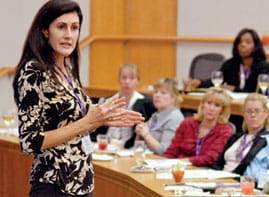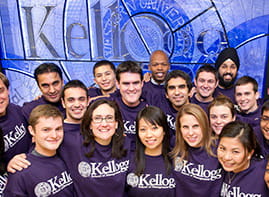Kellogg EduIndia Team Wins Kellogg-Morgan Stanley Sustainable Investing Challenge
Making the World a Better Place While Also Making Money
By Jeanette Brown4/17/2017 - Earlier this month, 10 teams from business and other graduate schools from around the globe convened at Morgan Stanley’s New York offices for the Kellogg-Morgan Stanley Sustainable Investing Challenge. At the end of the day, low-income primary and secondary students in India may just end up being the biggest winners.
The annual competition, now in its seventh year, brings together bright teams of graduate students from leading business schools and other institutions to apply financial know-how and ingenuity to tackle some of the world’s thorniest problems. Known as sustainable investing, it’s an investment discipline that considers environmental, social and corporate governance (ESG) criteria to generate long-term competitive financial returns while also having a positive social impact—and it’s quickly gaining traction. In 2016, $8.72 trillion—or more than one of every five dollars under professional management in the United States alone—was devoted to sustainable, responsible or impact investing strategies, according to US SIF: The Forum for Sustainable and Responsible Investment. That’s up 33 percent since 2014 and represents a 14-fold increase since 1995. Because not only is it the right thing to do, it’s also profitable.
And business school students are paying attention and getting involved. EduIndia—a team comprised of three MBA students from Northwestern’s Kellogg School of Management—took top honors at Friday’s finals for its novel idea to help meet growing demand in India for higher-quality, affordable K-12 private education. Poor conditions in cash-strapped Indian government schools have led parents to increasingly seek out private education for their children, so much so that low-fee private schools, which charge roughly $8 a month per student, simply can’t keep pace with the demand and are in desperate need of growth capital. But existing loan options that would be required to fund expansion for these schools come with extremely high interest rates, placing them out of reach for more than half of those that need them.
Enter EduIndia and its creative solution: a private growth debt fund that can provide schools with the growth capital they need to expand at terms much more attractive than existing options, including allowing schools to repay based on a percentage of revenue. Addressing another problem faced by the schools, EduIndia’s proposal also promises to help retain students who are struggling to pay tuition by offering parents low-cost student tuition loans from partner microfinance institutions that in turn are guaranteed by the fund.
“Unlike a loan that has a fixed interest rate, the private debt fund we proposed allows schools to repay in a more flexible manner that is better for them,” explains EduIndia team member Erica Hoeveler. She and Kellogg classmates Ashwin Halgeri and Chris Shaw started with a proposal that was closer to a standard loan and then began the process of refining it. “In the beginning, we thought about more traditional mechanisms, but by talking to the schools were realized it was not the best structure,” Hoeveler says. “We adjusted our proposal to match the schools’ needs, plugging other features in to make it make more sense to them.”
Inspiring students to innovate conventional financing vehicles or devise new ones in ways that can help address global social and environmental challenges was exactly the goal of the Sustainable Investment Challenge when Kellogg launched it in 2011. Morgan Stanley came on board as a co-host four years ago.
SUSTAINABLE INVESTING GOES MAINSTREAM
“When this challenge began, the concept of using market-based financial tools and expectations of returns to address social challenges was viewed with some skepticism,” says Megan Kashner, Kellogg clinical assistant professor and director of social impact. “What we have seen in the marketplace in recent years is a shift of this type of investment from early edge to more mainstream.”
For Morgan Stanley, getting involved in 2013 made complete sense. “We saw the Sustainable Investing Challenge as incredibly well aligned for our Institute for Sustainable Investing,” says Cynthia Wong, vice president of sustainable finance. The firm’s sustainable investing institute was established that same year “to build on Morgan Stanley’s ongoing work to advance market-based solutions to economic, social and environmental challenges, operating from the foundational principle that sustainable investment can only achieve significant scale by attracting a broad range of private sector capital,” according to its website.
“Getting involved with the Kellogg competition provided an opportunity for us to engage, harness and inspire the next leaders in the space,” Wong continues. “The sustainable investing field is one that is still growing quite quickly, and we want to be part of driving that growth.”
Kellogg’s Kashner praises Morgan Stanley for its early involvement and celebrates the fact that more large-scale financial institutions are following suit. “Where this competition used to be a little bit novel and leading edge, it is now squarely in a trend,” she says. The competition has drawn attendees and sponsors from foundations and impact investors such as the MacArthur Foundation, the Milken Institute and Equilibrium Capital since its debut, but today there are hedge funds and large global integrated financial service firms coming in as judges, mentors and sponsors, she adds. “This is squarely within who they are and what they do in a way that it might not have been several years ago.”
That financial services firms increasingly see the value in sustainable investing makes perfect sense to Kashner. Sustainability is the strategic long-term management of resources, she says. “Financial markets have incredible power to move outcomes and to reflect and capitalize on trends, risks and opportunities. And so much of what we see in the realm of social investing is investing that leverages these capital markets to take into account long-term risks and returns for people on the planet,” she says. “That is central for all of us and for all of the companies. Why wouldn’t financial institutions be interested in this? Especially now that we have access to vast amounts of global data on how these environmental, social and governmental issues can have impact.”
Morgan Stanley’s Wong, for her part, credits millennials for some of this shift. “This competition is more important than ever now because we are seeing sustainable investing become a mainstream investing force,” she says. “Millennials really are the leading force behind this. We see it from both our millennial employees and our millennial clients—a growing desire to address social challenges through financial vehicles that achieve positive financial returns.”
COMPETITION’S APPEAL GROWS FOR STUDENTS, TOO
Student interest in the competition has kept pace with the growing appeal of sustainable investing among financial institutions. This year’s 10 finalist teams were selected from 196 students at 37 schools across 29 countries. The runner-up this year was a team from Columbia University’s School of International and Public Affairs with a proposal for monetizing the carbon 2 offset value of forestry companies.
Teams from other leading U.S. business schools—including Stanford Graduate School of Business, UC Berkeley’s Haas School, Duke’s Fuqua School and Dartmouth’s Tuck School of Business—also advanced to the finals, as did teams from INSEAD, the Ewha Woman’s University and the Graduate School of Management Technology at Korea University.
And the competition has only been getting stiffer each year. “We have seen the quality, professionalism and creativity of the prospectuses that we receive increasing year over year as the students and the marketplace becomes more sophisticated,” Kashner says.
For EduIndia, the decision to focus on education was a no-brainer. The three team members had met at education-related events and activities at Kellogg and then saw the announcement of the challenge and decided to take part. “We knew it should be education because the three of us all share a passion for it, and we like emerging markets as well, so we began studying and talking to people to identify challenges in the educational space,” Hoeveler says. Among the regions they considered were her native Brazil, Mexico, multiple countries in Africa, and India, where team member Halgeri was born. Ultimately, they decided to focus on India, Halgeri contacted some schools, and EduIndia was born. Hoeveler worked in banking for four years prior to business school at HSBC in Brazil, and third team member Shaw’s background is also finance. “For us it was the perfect combination—something that combined our background in finance with our passion in education,” Hoeveler says.
Other teams have tackled issues ranging from poverty to grasslands, healthcare to water. Last year’s winner was Terra Limpa, a team from USC Marshall School of Business, for its proposal of a for-profit method of clearing land in previously war-torn Angola of landmines, revitalizing it for agriculture and supporting a new class of small farming. Last year’s runner-up was Red Ribbon Fund, a team from UVA’s Darden School of Business with a proposal for achieving viral suppression in HIV/AIDS affected people in the United States by offering financial incentives for patients who stick with treatment, resulting in billions in saved healthcare costs and improved lives and survival rates for thousands of patients.
“There are some themes that we always see—such as carbon, energy access, sustainable farming—because these are themes that cut across continents, countries and communities,” says Kashner. Beyond those core themes, the competition also draws proposals to confront a wide variety of other social and environmental challenges, including flood mitigation, poverty, hunger, and social mobility. Competing teams are encouraged to draw from the entire spectrum of investment tools, styles and asset classes to make an impact.
Kashner has been especially pleased—in each of the two years she personally has been involved with the competition—to have seen at least one team focusing on market- and capital-based solutions to address the situation of refugees globally. Last year a team from London Business School proposed using microfinance to support refugee entrepreneurs in the European Union, and this year a team from Tuck proposed a real estate fund to sustainably finance affordable housing resettlement communities for internally displaced Afghans. “I am heartened to see students wrap their creative financial brains around what really is a global financial crisis,” she says.
MULTIPLE BENEFITS FOR MULTIPLE PARTIES
Beyond giving student teams critical experiential learning opportunities to collaborate and apply their finance skills to pressing global problems, the competition brings those students’ fresh perspectives to Morgan Stanley and other participating institutions—benefitting the growing field of impact investing as a whole.
“What I think is remarkable about this competition is that when you invite really bright graduate students from across disciplines to wrap their heads around using finance as a creative tool to address social and environmental issues, you get an incredibly rich array of possibilities that you wouldn’t get if you asked the same group to come up with operational suggestions,” says Kashner.
Says Wong: “This really is one of my favorite days of the year because it is so inspiring to hear the students’ ideas and see how innovative and creative they can be.”
Indeed, the event is a networking opportunity that is hugely valuable on multiple levels. “First, it gives student competitors the opportunity to rub elbows with some of the highest leading professionals in the field of sustainable finance,” says Kashner. “Second, these professionals are so interested in meeting, hearing, and learning from students who are in the academic realms of creativity and possibility,” she continues. “And the third realm of networking is among and between the judges and mentors and other attendees who come to hear these creative approaches—because the field of sustainable investment is really collaborative in its rapid growth and expansion.”
COMPETITION IS JUST THE BEGINNING
Combining monetary prizes—$10,000 for the winning team—hard work, and conviction, several past winners have gone on to take their concepts from idea to implementation. The 2015 winning team from Haas has spent the two years since developing its idea for combatting forest fire in California into Blue Forest Conservation (BFC). Through a unique public-private partnership with American Forest Foundation and World Resources Institute, BFC has developed an innovative financial tool that aligns market incentives to restore key watersheds and prevent fires—tackling dual issues of drought and wildfire and benefiting both landowners and investors. Last year’s winning team, Terra Limpa, has evolved into an early-stage venture fund supporting agricultural enterprises in post-conflict Angola.
Next steps for EduIndia will be attending the Milken Institute Global Conference—a premier annual gathering of international sustainability thought leaders—in Los Angeles in May while continuing to analyze ways to put their idea into practice, Hoeveler says.
Kashner was also very excited to announce that Kellogg—through a partnership with the Rockefeller Foundation—for the first time this year will offer a paid financial fellowship to allow one finalist team from any of the competition’s seven years to spend between nine and 12 months going deep with their idea and really trying to take it to market. The winner of the first fellowship will be announced in the next few months, she adds.
The annual challenge is one part of Kellogg’s larger focus on social impact. “At Kellogg we focus on the market-based levers for impact, in financial capital markets and elsewhere,” Kashner says. “Overall, Kellogg is concerned with the opportunity to inform and prepare the next generation of business and financial leaders to go out and lead with a long-term view.” Running a sustainable investment challenge with Morgan Stanley each year is part of the school’s efforts to contribute to the leadership and learning of students at Kellogg and around the globe, she adds.
“Morgan Stanley believes that business can and will lead the way in improving sustainability and human outcomes,” says Wong. “And Kellogg has created a really great model of helping students focus not just on cool business ideas but also on financial ideas that are innovative and promise both profit and impact. If finance can be see part of the solution to some of the biggest challenges we have and be seen as an attractive, interesting investment opportunity at the same time, that’s the future.”






